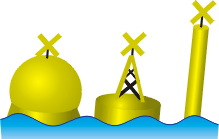

A Special Mark, as defined by the International Association of Lighthouse Authorities, is a sea mark used in maritime pilotage. It is recognisable by its yellow colour and "X" (also referred to as a St. Andrews Cross or saltire) top-mark. If a light is fitted the light is always yellow in colour and can have any light characteristic which differs from those used for cardinal marks, isolated danger marks, mobile aid to navigation marks and safe water marks. [1] [2]